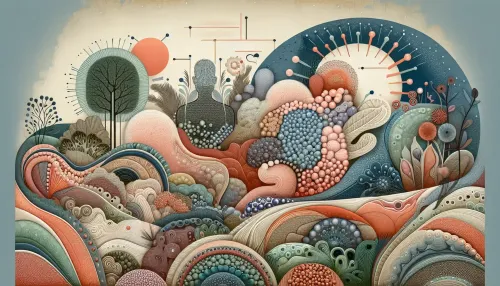The Alchemy of Essential Oils: Unveiling the Science Behind Aromatherapy’s Therapeutic Effects

Aromatic essences have transcended time and culture, seeping into the very fabric of health and wellness practices around the globe. Today, on Peppino Blog, we delve into the intriguing alchemy of essential oils liquid wonders derived from nature’s pharmacy to unveil the science driving aromatherapy's therapeutic effects. Let's immerse ourselves in the molecules that enchant our senses and influence our well-being.
Mysterious in their essence and potent in their effect, essential oils are composed of a complex array of chemical constituents. The magic begins at the molecular level, where these aromatic compounds permeate our olfactory systems or skin. Limonene, linalool, and other volatile organic compounds whisk away through the air, finding a receptive home within our nasal receptors. Once there, they coax the limbic system to alter mood, memory, and even hormone balance.
Molecular Interactions of Essential Oils
In addition to olfaction, topical application tfransports these molecules through dermal absorption. They travel through lipid membranes and ultimately enter the bloodstream venturing to various biological systems where they exert a kaleidoscope of actions from anti-inflammatory to antimicrobial.
How essential oils affect the olfactory system
The confluence of scents and emotional equilibrium is a riveting chapter unfolding within Peppino Blog’s exploration of health trends. Aromatherapy isn't merely a sensory indulgence; it has a profound impact on mental health. The scents emanating from lavender fields or dense spruce forests encapsulate calming agents comforting evidence of nature’s capacity to impact mood.
Related Article: The Science of Sleep: Optimizing Your Rest for Health and Vitality
Aromatherapy and Emotional Well-being
The marriage of antiquity’s wisdom with modern science faces its share of challenges. Validating aromatherapy demands rigorous clinical trials a process laden with complexities due to the personalized nature of scent perception and reaction. However, pioneers persevere; they strive to quantify benefits through double-blind studies, measuring stress markers or tracking sleep quality improvements among participants exposed to essential oil interventions.
The impact of scents on mental health
Pharmacognosy the study of drugs derived from natural sources heralds a blend between enzymatic extractions and medicine cabinets.
Clinical Validation of Aromatherapy Efficacy
Integrating aromatics within conventional therapy invites a cross-pollination with pharmacology hitherto untapped at scale. Imagine chemotherapy aided by peppermint's anti-nausea embrace or surgery recovery rooms smelling faintly of eucalyptus to promote respiratory ease.
The Future of Plant-based Medicine
One does not simply apply a lemon balm protocol across the board uniqueness reigns supreme in the realm of essential oil therapy. Precision wellness advocates have been championing bespoke blends that address asymmetric biochemical landscapes across individuals.
Integrating aromatherapy into conventional therapies
In this vast landscape of healing fragrances, not all oils are created equal. Purity is non-negotiable; adulteration negates efficacy. Thus springs forth a demand for stringent testing from gas chromatography to mass spectrometry to validate authenticity.
The importance of customized essential oil blends
Veering beyond lavender-infused pillow sprays for improved sleep quality lies a frontier ripe for exploration: disease prevention. Research corridors are buzzing with anticipation as scientists scrutinize tea tree vapors for their antiviral properties, or dissect cinnamon bark for its insulin-mimicking components.
Related Article: Gut Instincts: Leveraging the Gut Microbiome for Optimal Health
Ensuring Quality in Essential Oils
The evolution of delivery devices from rudimentary oil diffusers to sophisticated nebulizers parallels our deepening understanding of essential oil kinetics. The latest apparati boast features that enhance bioavailability think ultrasonic waves breaking down particles into breathable mists or cold-air diffusion preserving delicate essences intact.
Aromatherapy's Role in Disease Prevention
Lastly, competence in conveying aromatherapy's benefits hinges on knowledgeable practitioners—a need filling course catalogs worldwide. As amateur enthusiasts evolve into certified professionals through rigorous syllabi encompassing anatomy to olfactory science, Peppino Blog congratulates this growing cohort destined for transformative roles within integrative health disciplines.
Frequently Asked Questions
Essential oils possess therapeutic effects due to their complex chemical constituents. When inhaled or applied topically, these oils interact with the body’s olfactory and dermal systems, influencing mood, memory, and hormone balance. Their benefits range from anti-inflammatory properties to antimicrobial actions, making them valuable in health and wellness practices.
Aromatherapy significantly affects emotional well-being by utilizing scents that evoke calming responses. For instance, the aroma of lavender can reduce anxiety and promote relaxation. The connection between specific scents and emotional states underscores the potential of aromatherapy as a therapeutic tool for enhancing mental health and emotional equilibrium.
The quality of essential oils is crucial because adulterated or impure oils can negate their therapeutic efficacy. Ensuring purity involves rigorous testing methods such as gas chromatography and mass spectrometry. High-quality essential oils maintain their intended benefits, making them effective for therapeutic applications in aromatherapy.
Check Out These Related Articles

Syncing with Circadian Rhythms: Pioneering Sleep Science for Optimal Well-Being

Microbiome Insights: Revolutionary Findings on Gut Health and Its Impact on Mental Well-Being

Nano-medicine: Redefining Drug Delivery Systems for Enhanced Wellness Outcomes
